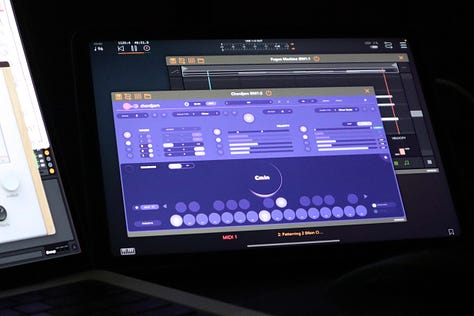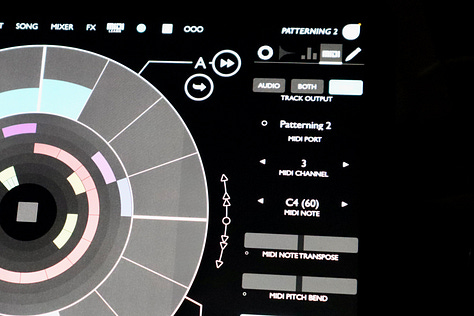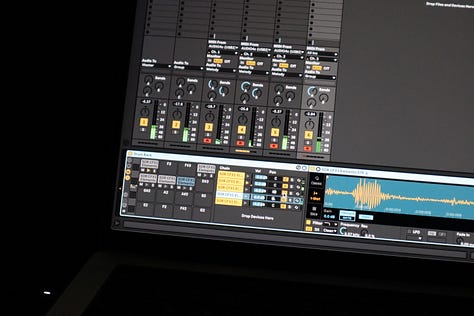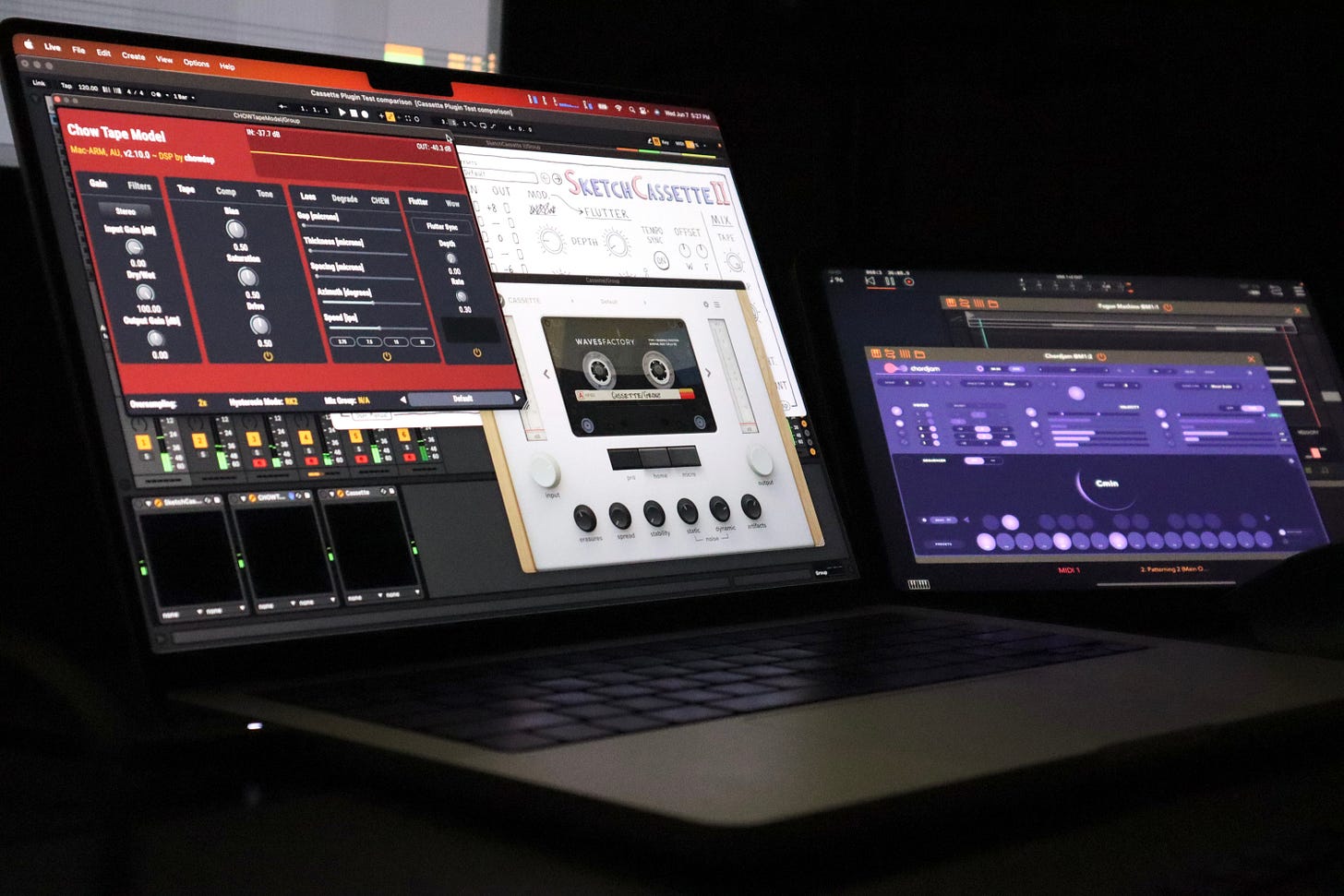Playheads as plugins
A comparison of three digital tape effects
Today’s note will explore my favorite plugins for producing cassette-like effects: compression, distortion, wow & flutter, etc. This isn’t meant to be an exhaustive demo of all parameters, or to answer “which is the best.” I’m just going to focus on explaining the specific elements that I like the most in each one of these tools, and how I prefer to use them. I’m also going to clearly identify the differentiating features between them in order to help you make a decision about which might be most useful to you.
The effects in question are:
Aberrant DSP Sketch Cassette II ($30 - Mac/Win)
ChowDSP Chow Tape Model (Free - Mac/iOS/Win)
Wavesfactory Cassette ($59 - Mac/Win)
What a time to be alive! Endless variety and pinpoint accuracy for $89 total. I’ve definitely spent more than that on tapes, recorders, and mics over the years, not to mention the endless stream of pedals.
I’ve broken out each effect overview and video into separate sections down below, but if you just want to view the full, uncut video demonstration of all the effects without my opinions interspersed, you can watch that on my YouTube channel here:
First, story time…
Growing up in the ‘90s and early 2000s was a wild time for music consumption. I vividly remember subscribing to a mail-order service that sent me 6-12 jazz CDs a quarter. The excitement of opening the package and digesting the new-to-me music, disc by disc, then burning and cataloging the tracks in my iTunes library, was unmatched. I was also trading burned CD-Rs almost every week with my bandmates in high school as we worked out our demo tracks and listened to new artists for inspiration. A copy of “Zenyatta Mondatta” by the Police was looping for more than a year straight in the CD player of my car that my brother and I shared. CDs were everywhere back then.
Alongside the established CD format was an emerging digital music ecosystem. I was listening to my friends’ bands on Purevolume and MySpace (promoters booking local shows were starting to ask questions about “playcounts” as a proof of legitimacy and a qualifying factor for playing at certain venues), and I was also downloading gigabytes worth of torrents on Kazaa and Limewire. Occasionally I’d pay 99 cents for a track on iTunes just to lessen the shame. My digital library eventually outgrew my CD collection, and the MP3 hoarding would culminate in a guilt-ridden deletion of all the pirated files from my hard drive one night during my junior year of college.
I mention this because I’m still fairly new to cassette tapes: cassette tapes weren’t a part of my listening habits at all. I didn’t even own a tape player until a friend offered to print a batch of hand-dubbed cassettes for our debut Hotel Neon album in 2013. I thought it was a fun (sort of stupid) novelty at first, but eventually I found the format to be so genuinely charming and interesting that I started browsing thrift stores and eBay to find old tape decks and handheld recorders to use in my recording process. All the defining characteristics of a cassette that you can think of were the same ones that captured my attention: the low fidelity, the hiss, the warble, the distortion, etc. Since then, the cassette tape has grown to play a pretty big role in my musical process. A lot of my albums have been released on tape because I appreciate what it does to their sound, but I also use cassettes to shape the source material to begin with.
I love the medium as a DIY distribution method for recorded music. To me, there’s always been something a little more interesting and approachable about cassette culture compared to vinyl or CDs. There are exceptions, of course, but there’s generally not nearly the amount of nitpicking or investment involved to set up a tape deck for listening. People come to the format knowing that there is an inherent quirkiness about it, and accuracy isn’t always the goal. I really appreciate that low barrier to entry.
Most importantly, I love the cassette tape as a creative sound shaper in my recording workflow. The terminology around tapes does get a little repetitive and meaningless after a while (words like “analog warmth” get tossed around without much thought), but there is real, undeniable magic in the way cassettes can degrade, compress, and distort sounds, sometimes severely and always uniquely. The imperfection it imparts on source material is endlessly fascinating and I’m still not tired of it, years later.

The funny thing is that I hardly use my actual tape recorders anymore. Digital modeling has become so accurate, efficient, and frankly enjoyable to use that I use plugins to get “that tape sound” 9 times out of 10. I don’t think I’m ready to get rid of my recorders altogether - there’s still something to be said for processing specific sounds by hand every now and then - but usually, it’s just not worth the hassle for me to pluck them out of storage when I have incredible software available.
The setup and process
Here’s how the session looked behind the screen:



To demonstrate each of these plugins, I’ve prepared some video demos of each one affecting the same looping sequence. Each of the tape sims is loaded on the master output, and I toggle between each of them to explore the available sounds.
I programmed a drum beat in Patterning 2, which is sending MIDI to play a drum rack in Ableton Live that I loaded with a few IDM/glitch drum samples from one of my favorite sample packs (here). That’s accompanied by a 3-part melodic sequence played by Fugue Machine and Chordjam on the iPad: Noire Piano, Landforms strings, and an Ableton bass synth are the instruments used.
Here’s what all that sounds like, unaffected:
Aberrant Sketch Cassette II
Pros: excellent overall sound quality; NR Compression tool is genuinely useful as a tone shaper; mix knobs allow for blending in subtle effect levels
Cons: no resizable UI; graphics not to everyone’s taste; no built-in filter or EQ
My preferred use case: this is a great overall tape effect for most any use case, and it’s hard to dial in a bad-sounding effect, but I find the compression and saturation to be the most pleasing part about it. Thanks to the depth and mix knobs, you can blend in subtle amounts of natural-sounding overdrive and high end sparkle with your dry signal. It can get very destructive if you want it to, but I find it more useful at taker settings. It’s great for adding subtle amounts of breakup and tone enhancement to almost anything you throw at it.
The folks at Aberrant DSP have been releasing quality effects for a while now - it’s well worth the time to visit their site and read up on them. In addition to Sketch Cassette, I can personally vouch for and recommend Digitalis as a truly unique take on bit crushing, digital glitching artifacts, and sample rate reduction.
Sketch Cassette may be the most popular of the bunch, though, and for good reason: it simply sounds excellent. I think what strikes me most about this effect is how every setting seems to be usable; there are truly no bad places to land on any of the dials. It’s a great “give me a cassette tape and give it to me now!” type of choice to have available.
Hidden inside the control panel is a surprising amount of variation, including a good degree of control over the wear of the tape using the “Cheap/Value/Standard/Master” toggles in conjunction with the “Age” slider. This can cover a lot of ground, and having a Mix control knob to blend it in with an unaffected dry signal means a wide variety of sounds are possible.
Check them out here:
The standout features for me, after playing with this effect for a few months now, is the compression and saturation that’s on tap. Saturation can be toggled between 2 options (A and B) for varying flavors of distortion, but again, no matter where you land, there’s a really satisfying and tasteful quality to it. It’s not as destructive as what can happen in Chow Tape, but it’s arguably more widely usable for most uses.
NR Comp is the star of the show here, in my opinion. Based on the sound shaping that happens in Noise Reduction circuits found on some tape decks, it adds quite a punchy sparkle to the tone of the tape. This is especially useful on “Cheap” and “Value” tape types that suck a lot of life out of the top end, and helps restore some of the frequency range that’s lost there. Most useful of all is the ability to blend in the compression independently of the overall Tape Mix. This makes Sketch Cassette a pretty effective dynamics processor in its own right, and will no doubt find some use in specific situations that call for high-end sheen and sparkle to cut through. I really enjoy putting drums through this effect, with the tape effects completely bypassed at times.
ChowDSP Chow Tape Model
Pros: free; also available as an iOS and iPadOS app; widest range of fidelity; exceptional sound quality
Cons: design aesthetics are pretty bland. Not a big deal, I just had to come up with something!
My preferred use case: this is my favorite all-around tape effect. It does an excellent reproduction of a lo-fi tape recorder’s sound when the low-cut filters and degradation effects are engaged, but it really excels when placed on the master bus at higher fidelity settings - especially with higher tape speeds at 15 ips and above. It’s an excellent way to warm up a mix with slight overdrive and compression.
The developer behind Chow Tape, Jatin Chowdhury, takes a deeply considered and analytical approach to his plugins with ChowDSP. This makes perfect sense given that he’s a USC- and Stanford-educated engineer with a master’s degree in audio tech and signal processing. His 2019 paper, “Real-Time Physical Modelling for Analog Tape Machines,” is required reading for musicians approaching tape. It deftly explains the properties and mechanics of the Sony TC-260 reel-to-reel tape machine that Chow Tape is based on, and defines terms like “wow” and “flutter” in more meaningful ways than most consumer-facing product manuals. It’s an essential reference guide that I still open occasionally to better understand what’s happening to my audio when it encounters magnetic tape.
Chow Tape is astonishing in its accuracy and incredible in its flexibility. I find it to be my all-around favorite of the three plugins I demo here, mostly because of its huge range of sounds. It can cover anything from the lowest of lo-fi featuring completely out-of-control destruction, all the way up to tasteful and hi-fi tonal sweetening suitable for a master bus. If I was to recommend only 1 option from the list, I’d nominate Chow Tape.
The added benefits: it’s free (yes, ZERO DOLLARS), and is also available on iPad and iPhone apps. You can take the effect with you on any platform at no cost.
Take a listen to the sheer range of sounds available:
You probably noticed it in the demo, but the ability to adjust the tape’s speed from 1-50 ips allows you to mimic anything from a traditional cassette recorder’s pace (2-3.75 ips) all the way beyond studio-quality reel speeds (30+ ips). This access to higher fidelity settings is a huge benefit not available on the other plugins, which are explicitly designed to mimic consumer-grade cassette gear. Maybe it’s not a fair comparison, then, but I think it’s worth mentioning if you’re trying to find the most widely useable of the 3. You can also adjust the physical properties of the tape itself (spacing, thickness, and gap to playhead) to darken and brighten the tone at will, at any tape speed, independent of the filtering and EQ options at hand.
A unexpected advantage for Chow Tape is a powerful set of wow and flutter controls. These are typically your standard “warbling pitch” controls on most tape effects, but they are particularly fun and interactive on Chow Tape. You’ll notice that at one point in the video, I push these controls to their maximum and total distorted chaos ensues. Amazing! These extreme levels of destruction aren’t possible with the W&F modes found on the other plugins, and allow for some really creative interplay with the more obvious distortion controls placed elsewhere in the UI: bias, input level, saturation, drive, etc…endless options for creative distortion abound. You can just imagine what’s possible when you route modulation sources like LFOs to multiple parameters at once.
I could continue with the high praise for this plugin, but I’ll stop there. I give Chow Tape my highest recommendation, and encourage everyone with an interest in tape effects to download it now on the platform of your choosing.
Wavesfactory Cassette
Pros: excellent handheld recorder speaker emulation; ability to simulate up to 4 layers of “re-recorded” tape is a unique sound effect; beautiful UI
Cons: higher-fidelity modes can emphasize the low midrange more than expected
My preferred use case: I always reach for Cassette when I’m on the hunt for intentionally crusty and lo-fi sounds, and specifically the low cut filtering effect of small speakers. On the “micro” settings, Cassette absolutely nails the sound of my beloved Sony TCM-200 handheld recorder. The “Re-Cassette” feature is clever and I use it all the time to generate unique degradation effects that come from recycled tapes. This effect is absolutely at its best when going for obviously degraded and low-fidelity sound.
Wavesfactory makes beautiful-looking plugins, that much is for sure. I love Trackspacer (sidechain/dynamic mixing EQ) and Echo Cat (Watkins Copicat tape delay sim) so much: they’re extremely effective, useful plugins in their own right and I would encourage everyone to try them. I use them in my mixes all the time.
In keeping with their model of GUI excellence, Wavesfactory’s Cassette has a crisp, clean design that places the moving playheads of a cassette tape right smack in the middle of your screen, immediately focusing your attention on the fact that your audio is being sent through one of those relics. It looks genuinely engaging and makes you want to reach out and use the knobs on screen.
There are 4 different variations of tapes to cycle through, ranging from a consumer grade/low bias model (with a limited frequency range and reduced high end) all the way up to a professional/hi-bias version with extended clarity in the high end frequencies that come at the slight expense of a reduced bass presence. There’s a lot of tonal variation here, even if you don’t have access to the same kinds of precise high- and low-pass filters and EQ available on Chow Tape.
Here’s what it sounds like in action:
My opinion is that Cassette really shines when mimicking the more decayed, lower-fidelity end of the audio spectrum, and it does so with startling accuracy relative to some of the equipment I’ve actually owned. For instance: I’ve long been a fan of the Sony TCM-200, mostly because of the ease of use but also because the sound emanating from its tiny front speaker is cracked, distorted, and squashed in all the right ways. It’s the sound I think of when I hear “lo fi tape” and the most immediate reference point I use when trying to land in that domain, and Cassette can really nail it. For that reason, it’s become my go-to plugin when I want a “small speaker” sound. Most of my time with this effect is spent exclusively within its “micro” mode in order to capture that vibe with minimal effort.
In addition, I find the implementation of a “re-cassette” effect in the settings menu really clever and it’s a differentiator for this plugin. It replicates the degradation and loss of quality that happens to a tape when you record over it, and you can choose to make the tape sound like it’s been recorded up to 4 times over. When combined with things like the azimuth and stereo width parameters, sounds can become very narrow and sharp. It’s a faithful representation of what it actually sounds like when you’re pushing audio through the tiny speakers on those old handheld recorders.
One thing I would mention is that in my use over the last few years, I’ve consistently noticed that settings in the “home” and “pro” playback settings can sound quite boxy in the lower midrange, particularly in the Type 1 cassette. That’s to be expected in a tape machine, of course, but I feel that it’s slightly over-exaggerated in this plugin. That’s why I prefer to use Cassette as a way to replicate small handheld recorders on the “micro” settings, regardless of tape type.
Conclusion
So there you have it - these are the 3 software effects I use for all kinds of tape-tinged sounds. I think each has their place, and I’m glad they’re available in place of my old recorders.
Once again, if you’re interested in viewing the uninterrupted video with all three effects back-to-back, I’ve placed that demo on my YouTube channel:
I hope you found this write up interesting and useful. Thanks, as always, for reading!
AT




What a thoughtful, detailed look at this topic. Incredibly useful for me, I use a LOT of processing like this for my beats here at PolyesterCity, so I will be checking these out. Thank you so much for the work that you put into this and all you do!
Great rundown, as usual - thanks Andrew! I especially liked the demo of SketchCassette II, not only because I had not heard of it before, but also I think I ended up liking that one the best of the three (though props to Chow Tape too - can't beat that price! :-)). This presentation was also just a good reminder about what a wonderful effect lo-fi tape can be in general. Whenever I hear this sort of thing it always brings to mind listening to a faded cassette copy I had back a long time ago of David Sylvian's "Alchemy: Index of Possibilities" (one of my desert-island listening selections, for sure); side B was a side-long piece called "Steel Cathedrals", that always sounded to me like it was deliberately recorded with tape hiss, which seemed kind of warm and appealing, like vinyl crackle.